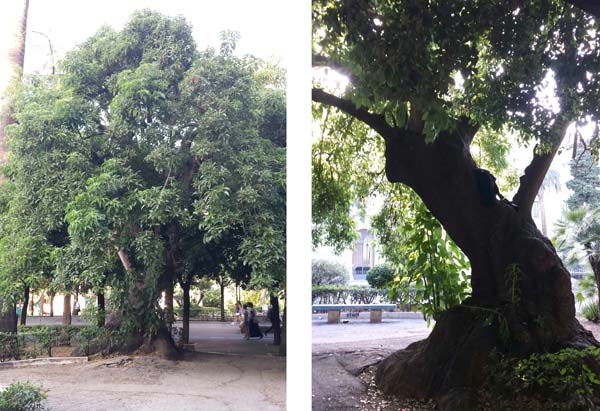
The Ombù tree in Giardini di Piazza Umberto I
This post is also available in:
 Italiano (Italian)
Italiano (Italian)
The garden on Piazza Umberto I is actually a public park, without fences, considered as the green heart of the Murattiano district of Bari; it can be found between the railway station and Via Sparano, the city’s shopping area.
The current layout of this park comes from two previously merged gardens, redesigned to surround the bronze equestrian statue of Umberto I in 1905: a tribute to the King by the city of Bari.
In the garden, visitors can find plants of the tropical and neotropical flora, coexisting with Mediterranean evergreen tree species and reflecting the thriving cultural and commercial exchanges at the end of the XIX century.
The garden has managed to preserve its original layout, with pedestrian paths winding through tree-lined flowerbeds bordered by low brick fences. Watching over this beautiful green space, there’s one of the Monumental Trees of Puglia: an Ombù (Phytolacca dioica L.), with a trunk circumference of 8.2 ft and a height of 20 ft.
Photo source: www.pugliain.net
Phytolacca dioica
– biology and ecology
This tree comes from the prairies of South America, also originally growing in southern Brazil, Argentina, and Paraguay (as regards the latter, it is mainly found in the “pampas” – the grasslands).
– distribution
This species was imported in Europe (in areas with Mediterranean climate) as an ornamental plant.
– importance and use
The ombù arrived in Italy in the mid-XIX century and quickly adapted to the Mediterranean environment and areas where temperatures never drop below zero.
It’s resistant to saltiness, thus often seen on the avenues near the sea.
It is a large semi-deciduous tree with an expanded crown that can grow more than 33-ft wide: that’s due to the enormous growth of its stem, which can embed the trunks of nearby trees and other obstacles.
This post is also available in:
 Italiano (Italian)
Italiano (Italian)
Contatti
Piazza Umberto I - 70121 Bari(BA)
